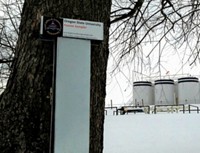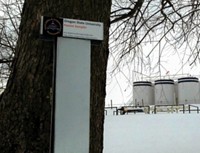Advertisement
Grab your lab coat. Let's get started
Welcome!
Welcome!
Create an account below to get 6 C&EN articles per month, receive newsletters and more - all free.
It seems this is your first time logging in online. Please enter the following information to continue.
As an ACS member you automatically get access to this site. All we need is few more details to create your reading experience.
Not you? Sign in with a different account.
Not you? Sign in with a different account.
ERROR 1
ERROR 1
ERROR 2
ERROR 2
ERROR 2
ERROR 2
ERROR 2
Password and Confirm password must match.
If you have an ACS member number, please enter it here so we can link this account to your membership. (optional)
ERROR 2
ACS values your privacy. By submitting your information, you are gaining access to C&EN and subscribing to our weekly newsletter. We use the information you provide to make your reading experience better, and we will never sell your data to third party members.
Atmospheric Chemistry
Fracking air pollution study retracted
Corrected results show airborne polycyclic aromatic hydrocarbons near fracking operations in Ohio do not pose elevated cancer risk
by Deirdre Lockwood
August 5, 2016

Because of calculation errors, researchers have retracted a 2015 study showing that airborne pollutants known as polycyclic aromatic hydrocarbons (PAHs) near fracking sites in Ohio posed elevated cancer risk to area residents and workers. In a new paper, the team reports corrected PAH values that are about 0.4% of those originally reported. In contrast to the original study’s conclusions, the researchers estimate that exposure to these PAH levels does not exceed the Environmental Protection Agency’s acceptable risk levels for cancer (Environ. Sci. Technol. 2016, DOI: 10.1021/acs.est.6b02762).
PAHs are found in fossil fuels, so they can be released into the air through natural gas extraction, and they are also produced when the fuels are burned, such as in truck exhaust near fracking sites. Because they are linked with cancer and respiratory illness, Kim A. Anderson of Oregon State University and her collaborators set out in winter 2014 to measure their airborne concentrations in Carroll County, Ohio, an area with high fracking activity. They deployed passive air samplers made of low-density polyethylene strips to absorb PAHs in the air for several weeks on the private properties of 23 volunteers. (Environ. Sci. Technol. 2015, DOI: 10.1021/es506095e).
After analyzing the concentrations of PAHs on the strips, the researchers estimated airborne concentrations of PAHs for three subsets of volunteers, grouped by their property’s proximity to an active well: within 0.1 mile, between 0.1 and 1 mile, and between 1 and 3 miles. The researchers originally reported that a set of 14 PAHs had total concentrations of 330, 240, and 210 ng/m3 for the three groups, respectively. But they later discovered that they had mistakenly used a value of the ideal gas constant with incorrect units in their calculations to determine the air concentrations of PAHs and to adjust them for sampling temperature, Anderson explains. This error invalidated the original results. The corrected values are much lower, at 1.2, 0.94, and 0.97 ng/m3, on the same order of magnitude as PAH values at rural sites far from natural gas production and values measured near natural gas wells during the drilling phase only (Hum. Ecol. Risk Assess. 2012, DOI: 10.1080/10807039.2012.749447).
The researchers then recalculated the excess lifetime cancer risk level for these concentrations at a variety of different exposures, including maximum residential exposure of 350 days per year over 26 years. In contrast with their previous results, which showed that the maximum exposure exceeded the EPA’s maximum acceptable risk level, the corrected risk levels were 0.04 in a million—well within the EPA’s most conservative acceptable risk level of 1 cancer in a million.
Two major conclusions from the original paper hold. “We still see higher PAH concentrations closer to wells than farther away, on average,” Anderson says. And the forensic profile of the PAHs is consistent with a natural gas source rather than a combustion source, such as from vehicle traffic near fracking operations.
“I respect the authors for issuing a retraction after they discovered their own mistake,” comments David O. Carpenter, an environmental health scientist and director of the Institute for Health & the Environment at the University at Albany, SUNY. “This is the responsible thing to do, but not a step that every scientist would take.”
Carpenter notes that the new study shows elevated PAHs near fracking sites—and adds that the compounds can be harmful at any level. “The EPA standards are set at levels that are achievable in our modern (and contaminated) world, and should not be used to imply that any amount is without some danger,” he says. “But it is reassuring that the measured levels do not exceed EPA standards.”
The Independent Petroleum Association of America, a trade organization for the oil and gas industry, published several posts in response to the retraction and the corrected study on the website it sponsors, Energy in Depth (EID). “This is a prime example of a rushed study, designed to scapegoat fracking, that fails to fully vet the data collected—yet garners media coverage anyway,” wrote Seth Whitehead, a researcher for the website. An EID spokesperson told C&EN that the researchers’ own comments about the study design “should have raised some red flags in the media when the original was released.”
Anderson says that her team called each study participant to report the corrected data and notes that her group will also be holding meetings in Ohio later this summer to discuss the experiments with the community.
Because of the same error in ideal gas constant units, Anderson and coauthors also recently retracted another paper on PAHs in the air and water of the Gulf of Mexico after the Deepwater Horizon spill (Environ. Sci. Technol. 2014, DOI: 10.1021/es503827y). In this case, the correction did not change the results as dramatically, because the air temperatures used in their calculations for that study were closer to standard temperature, 25 °C, than those in the Ohio study (Environ. Sci. Technol. 2016, DOI: 10.1021/acs.est.6b02784). “All major conclusions still held,” Anderson says.





Join the conversation
Contact the reporter
Submit a Letter to the Editor for publication
Engage with us on Twitter